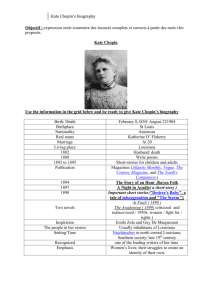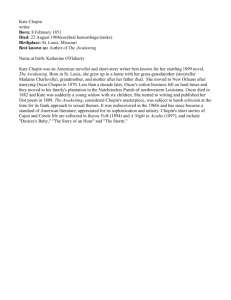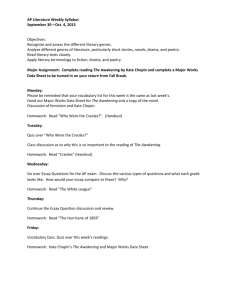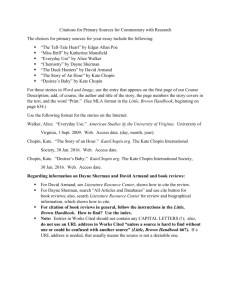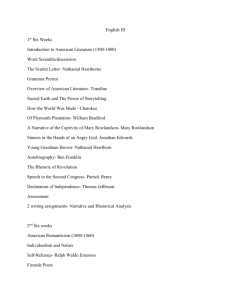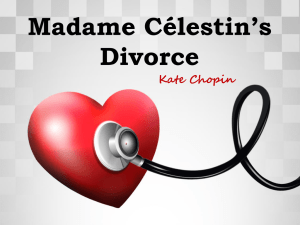Kate Chopin - Ms. McGraw's Messages
advertisement
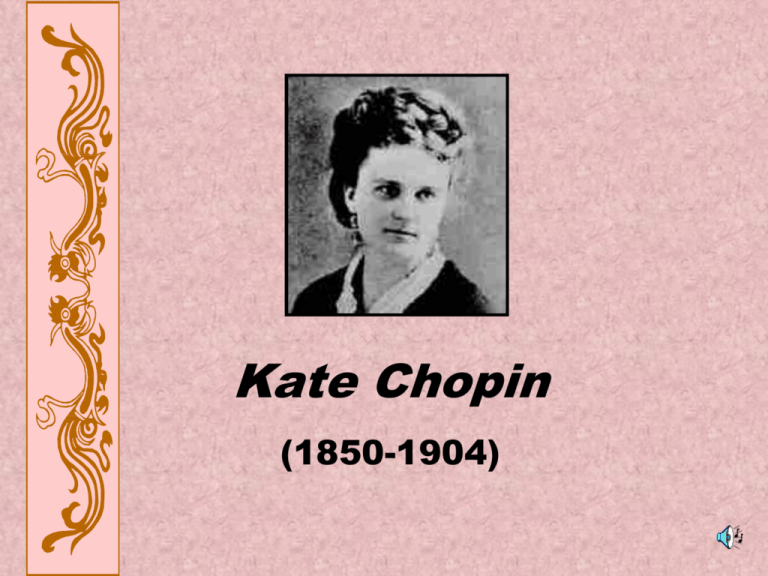
Kate Chopin (1850-1904) Katherine O’Flaherty • February 8, 1850 • St. Louis, Missouri • Thomas O’Flaherty, her father, was of Irish descent • Eliza Faris, her mother, was of French descent Strong Women • Eliza O’Flaherty – A member of the FrenchCreole community. Widowed at age 27, Kate’s mother never remarried. • Her grandmother, Madame Charleville, and great-grandmother had been widowed at an early age and never remarried. • Her great-greatgrandmother and her husband were the first to be granted a legal separation in St. Louis. Early Education • Sent to the Academy of the Sacred Heart at age 5, she left after only 2 months when her father died. • Her great-grandmother taught her music, history, French, and the need to “live life clearly and fearlessly.” Academy of the Sacred Heart Grand Coteau, Louisiana • Two years later, Kate returned to school. Kate’s Commonplace Book • After seeing her depressed, a nun encouraged Kate to begin a personal journal. • She wrote in her journal until the end of her three month honeymoon in Europe. Kate: The Woman • Met Oscar Chopin at 19 and married him on June 9, 1870. • Moved to New Orleans. • After the failure of his business, he moved his family to Natchitoches Parish. • Oscar died in 1883 after contracting swamp fever. • He left Kate with 6 children. Kate and Four of Her Children Kate: The Writer I suppose this is what you would call unwomanly; but I have got into the habit of expressing myself. It doesn't matter to me, and you may think me unwomanly if you like. • After having moved back to St. Louis, Kate’s mother died. • Kate started writing to ease her pain and to help support her children. Kate Chopin: A Re-Awakening • PBS peered into Kate Chopin’s world Click on the hyperlink to view a clip from the PBS documentary on Chopin’s life. The Awakening Grand isle, Louisiana http://www.literarytraveler.com/summer/south/chopin.htm "Perhaps it is better to wake up after all, even to suffer; than to remain a dupe to illusions all one's life." The Writing of The Awakening Cover of The Awakening http://www.pbs.org/katechopin/library/awakening/ "Having a group of people at my disposal, I thought it might be entertaining (to myself) to throw them together and see what would happen. I never dreamed of Mrs. Pontellier making such a mess of things and working out her own damnation as she did. If I had the slightest intimation of such a thing, I would have excluded her from the company. But when I found out what she was up to, the play was half over, and it was then too late." Scandal • After The Awakening was published in 1899, literary critics condemned her novel for the sexual promiscuity of the protagonist. • After a decade of writing, Kate Chopin ends her literary career. • Kate dies on August 20, 1904 of a cerebral hemorrhage after attending the St. Louis World’s Fair. Works Cited • “Academy of the Sacred Heart.” http://www.ashcoteau.org/ • “Classical Archives.” http://www.classicalarchives.com/ • “Kate Chopin.” http://www.womenwriters.net/domesticgoddess/chopin 1.htm • “Kate Chopin: A Re-Awakening.” http://www.pbs.org/katechopin/program.html • “Kate Chopin: A Woman Ahead of Her Time.” http://www.angelfire.com/nv/English243/Chopin.html Kate Chopin and Vogue! http://www.katechopin.org/#Vogue Local Color!! Now you teach! • Divide into your assigned groups and take the topic you have been given, research it, and create a brief PowerPoint of about 5 slides to teach us! • Include pictures!!!!! • Samii, Hunter L., Zach L., Troy: Define “Local Color” and what it means to be a French Creole (include the structure of the society) • Brady, Allison, Tom, Hayley: The landscape and location of the French Creole culture • Joseph, Summer, Charlene, Hunter J.: Architecture • Kaleigh, Joe, Joleigh, Janet: Clothing and Food • Palmer, Davis, Courtney, Ethan: Unique Customs • Megan, Casey, Brandon, Andrew: Language • Zoe, Monica, Mindi, Rebekah: Family Structure • Sarah, Trevor, Saoirse, Jake: Entertainment and Pastimes http://www.yale.edu/ynhti/curriculum/units/1992/2/92.02.02.x.htm l#j Realism in The Awakening http://public.wsu.edu/~campbelld/a mlit/realism.htm • Renders reality closely and in comprehensive detail. Selective presentation of reality with an emphasis on verisimilitude, even at the expense of a well-made plot. – Verisimilitude: depicting the truth • Character is more important than action and plot; complex ethical choices are often the subject. • Characters appear in their real complexity of temperament and motive; they are in explicable relation to nature, to each other, to their social class, to their own past. • Class is important; the novel has traditionally served the interests and aspirations of an insurgent middle class. • Events will usually be plausible. Realistic novels avoid the sensational, dramatic elements of naturalistic novels and romances. • Diction is natural vernacular, not heightened or poetic; tone may be comic, satiric, or matter-of-fact. Realism • Renders reality closely and in comprehensive detail. Selective presentation of reality with an emphasis on verisimilitude, even at the expense of a well-made plot • Character is more important than action and plot; complex ethical choices are often the subject. • Characters appear in their real complexity of temperament and motive; they are in explicable relation to nature, to each other, to their social class, to their own past. • Class is important; the novel has traditionally served the interests and aspirations of an insurgent middle class. • Events will usually be plausible. Realistic novels avoid the sensational, dramatic elements of naturalistic novels and romances. • Diction is natural vernacular, not heightened or poetic; tone may be comic, satiric, or matter-of-fact. • Objectivity in presentation becomes increasingly important: overt authorial comments or intrusions diminish as the century progresses.

